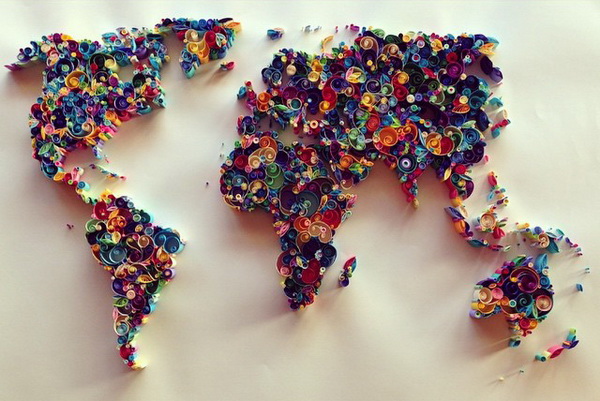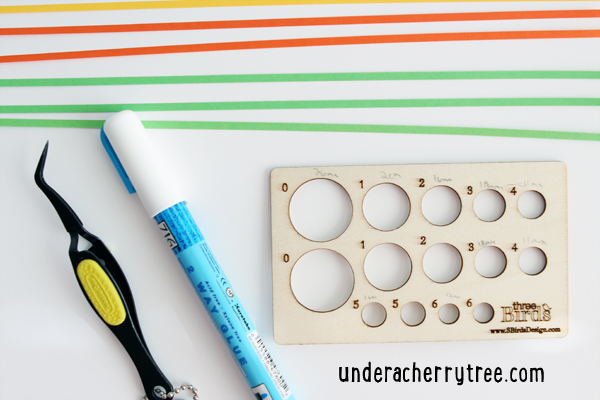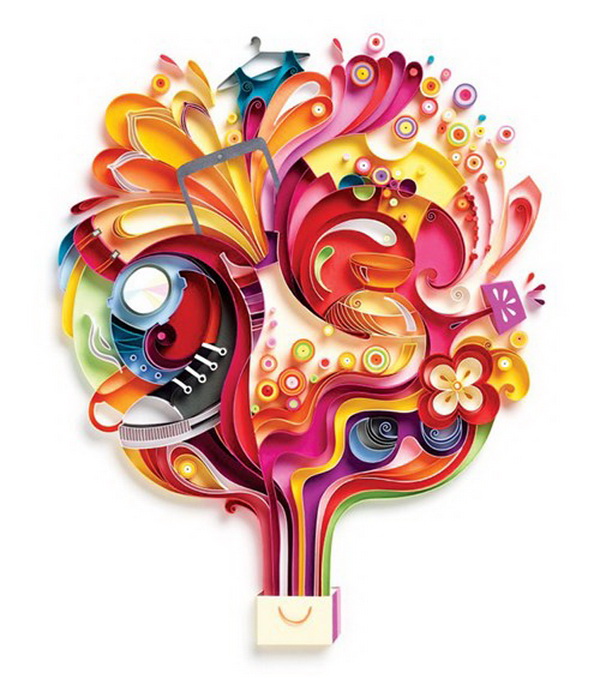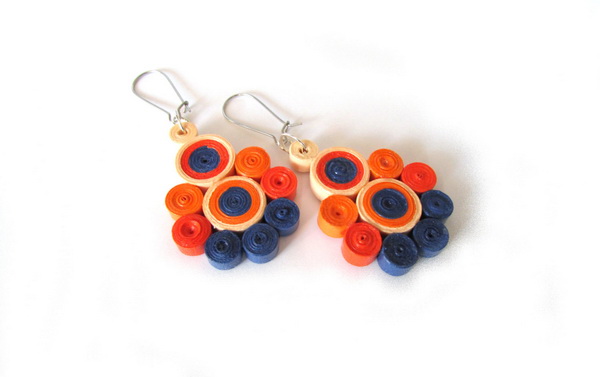Quilling or the art of paper twisting, paper rolling is how you use paper and aids to roll (not fold paper like Origami) and assemble those rolled pieces of paper into a complete work. With just colorful strips of paper, a little meticulousness, a little time, anyone can make your own Quilling.

History
There is no document about the origin of this art, however, it is still said that this art has been started since the invention of paper in China 150 years AD.
Rolling art is the art of decorating surfaces (furniture, gifts) by rolling paper, in which the decorative surface is made up of rolls of paper rolled from strips of paper of different colors and sizes together.
Another discovery of this art form is its appearance in Ancient Egypt. From another reliable source, in the 300s and 400s A.D., silver and gold threads were wound around to decorate columns and vases, combined with beautiful gems according to the technology this scroll. During the 1200s, this art was quite popular. When non-ferrous metals became scarce and difficult to make by hand, colored paper became more and more popular.
There are many debates about the origin of twisted paper paintings arise, many countries affirmatively claim the origin of this art from their own countries. In general, at least, we see in twisted paper a multicultural art in life.
Documents on twisted parchment date back to the 1200s, but are particularly evident from the 1500s and 1600s, when French and Italian nuns used the torn edges of bibles and rolled goose feathers to decorations for religious articles and pictures. The use of goose feathers has turned into the term "quill" (quill: originally meaning goose feather). Nuns (and devotees, priests) used goose feathers to recreate intricate ornaments with forged metal or ivory carvings, not using gold and silver but paper to make them completed work.
The bourgeois patriarchy made twisted paper paintings from the late 1600s, and early 1700s, (Stuart era). Historical facts show that the art of twisted paper became popular during the early 1700s to the early 1800s, (Georgian era) in Europe and England. Twisted paper art became fashionable and a private hobby for young girls, who were taught how to twist paper around a needle. The school promoted this art as part of the classroom, these twisted paper patterns are still around, the dates and names of the girls' schools are drawn in the background in pencil. This art became popular until the 1800s (Regency era) but became less popular by the late 1800s. Several attempts to recreate the late 1800s followed were unsuccessful.
The art of making twisted paper pictures is not a pastime for working class women. Instead, because this art appealed to idle class women, the working class applied it to decorate them with curtains, kitchen cabinets, picture frames, tea boxes, playing cards. , wine trays, baskets, tool boxes, pitchers, and even beds and furniture, Only this class had enough money to buy materials such as metal foil, mica, shell fragments, Often used as a background for paintings. And only upper-class women have time to make art paintings, not for a living, single men spend their time making paintings for their fiancées.
Immigrants brought this art to the United States, and it has gone through several stages of renaissance to this day. The craft has now merged into guilds and clubs thrive, and the need to decorate with twisted paper for folder folders, photo albums further enriches this craft.

Tools needed to make simple quilling
* Quilling paper rolls

To make twisted paper quilling, it is impossible without a paper roll - a great assistant to help you have a variety of quilling. There are 2 types of rolls you can choose from:
- Large-headed quilling stick: this type has a slot to clip the twisted paper, very suitable for beginners to learn to make quilling. Although this type is easy to use, the center of twisted paper is often large.
- Quilling paper rolls with extremely small needles: often used when you have mastered in making quilling.
Today, there are many types of paper rolls that are a combination of both types, or electric quilling sticks. If you don't buy it, you can also make your own roll with old sewing needles, sharp toothpicks...
2 types of quilling paper rolls make it easier to twist the paper
* Paper quilling

- These are pre-cut strips of paper, about 1cm in size or more, with different colors. You can buy them at souvenir shops, which are readily available, or make use of old newspapers and paperboards when you start studying.
Colorful twisted paper is available at souvenir shops
* White glue

If you are a fan of handmade products, you are no stranger to white glue. However, when using quilling to make white glue, you need to note the following:
- Do not use too much white glue to paste, it will make the paper soft, wet and curved.
- If you want to avoid getting too much glue, you should choose a box with a small nozzle, and then use the tip of the needle to attach the glue tube.
Because white glue is very easy to dry and clump, when using it, it should be mixed with a little water and after use you should cover it tightly for storage.
* Scissors

- To make quilling, you just need to use sharp scissors (used to press or trim small details) and serrated scissors to create a border for the paper strip.
* Other tools to learn how to make basic quilling
– Quilling locator and frame: make it easy to make quilling of different sizes
– Knife carving
– Quilling comb, locating needle
– Tweezers

Positioners for making quilling in different shapes and sizes.
Steps to pay attention to for beginners
* Use the right Quilling paper
The paper used is very important in starting the wrapping. It's best to buy pre-cut paper from stores. The length and size of the paper play a decisive role in achieving the desired result. The pattern of the decoration also partly reveals to the maker the type of size to use. Better to consult the seller before trying.
* Use the right tools needed
To roll paper, having the right kit is equally important. The type of tool used for beginners is usually a set for making simple patterns. However, these tools tend to be designed with grooves to make them easier to roll. The type of tool with a roll needle, although it is more difficult to use, is still preferred, because it creates a neater, more beautiful roll of paper.
Glue is an indispensable tool. Need more help of clamps to easily hold and stick as intended by the maker.
* Know the basic technique and shape
The most basic shape of the quilling roll paper is the core shape. By simply changing the force of the hand to twist and adjusting the tension of the paper core, different types of paper rolls were created. There are some other basic types such as tight core coil, liquid core roll, teardrop roll, semi-curved teardrop, S-curve, square roll, heart roll, eye roll…

*Try with simple products
Once you've started, and are enjoying the work you're making, it's easier to work on harder stuff. The simplest reels can also produce interesting and lively products.
Quilling is often used as a card or wall decoration, picture frame decoration. Sometimes it is also used as wearable items such as necklaces, rings or earrings.

* Find multiple references
Books, newspapers, the internet are limitless sources of creativity and ideas for those who love this art. Everyone has their own ideas, but learning from different sources is not a bad idea. In addition, beginners can also refer to friends or take a few short classes, if possible.

* Most importantly, always practice
This is an art craft, of course, the more you practice, the more proficient you will be and the more beautiful the product will be.





